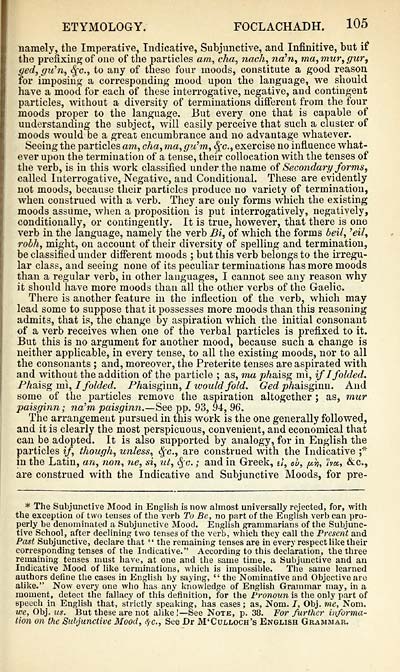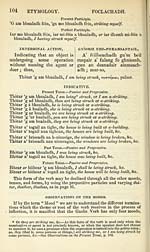Books and other items printed in Gaelic from 1841 to 1870 > Stéidhean a' Ghràmair Ghaëlig
(133) Page 105
Download files
Complete book:
Individual page:
Thumbnail gallery: Grid view | List view

ETYMOLOGY.
FOCLACHADH. 105
namely, the Imperative, Indicative, Subjunctive, and Infinitive, but if
the prefixing of one of the particles am, cha, nach, na'n, ma, mur, gur,
ged, gu'n, fyc, to any of these four moods, constitute a good reason
for imposing a corresponding mood upon the language, we should
have a mood for each of these interrogative, negative, and contingent
particles, without a diversity of terminations different from the four
moods proper to the language. But every one that is capable of
understanding the subject, will easily perceive that such a cluster of
moods would be a great encumbrance and no advantage whatever.
Seeing the particles am, cha, ma,gu'm, $c, exercise no influence what-
ever upon the termination of a tense, their collocation with the tenses of
the verb, is in this work classified under the name of Secondary forms,
called Interrogative, Negative, and Conditional. These are evidently
not moods, because their particles produce no variety of termination,
when construed with a verb. They are ouly forms which the existing
moods assume, when a proposition is put interrogatively, negatively,
conditionally, or contingently. It is true, however, that there is one
verb in the language, namely the verb Bi, of which the forms beil, 'eil,
robh, might, on account of their diversity of spelling and termination,
be classified under different moods ; but this verb belongs to the irregu-
lar class, and seeing none of its peculiar terminations has more moods
than a regular verb, in other languages, I cannot see any reason why
it should have more moods than all the other verbs of the Gaelic.
There is another feature in the inflection of the verb, which may
lead some to suppose that it possesses more moods than this reasoning
admits, that is, the change by aspiration which the initial consonant
of a verb receives when one of the verbal particles is prefixed to it.
But this is no argument for another mood, because such a change is
neither applicable, in every tense, to all the existing moods, nor to all
the consonants ; and, moreover, the Preterite tenses are aspirated with
and without the addition of the particle ; as, ma pAaisg mì, if Ifolded.
PAaisg mì, I folded. PAaisginn, / would fold. Ged jo^aisginn. And
some of the particles remove the aspiration altogether ; as, mur
paisginn ; na'm paisginn.—See pp. 93, 94, 96.
The arrangement pursued in this work is the one generally followed,
and it is clearly the most perspicuous, convenient, and economical that
can be adopted. It is also supported by analogy, for in English the
particles if, though, unless, Qc, are construed with the Indicative ;*
in the Latin, an, non, ne, si, ut, fyc ; and in Greek, ù, ol, ph, 'ìva, &c,
are construed with the Indicative and Subjunctive Moods, for pre-
* The Subjunctive Mood in English isnow almost universally rejected, for, with
the exception of two tenses of the verb To Be, no part of the English verb can pro-
perly be denominated a Subjunctive Mood. English grammarians of the Subjunc-
tive School, after declining two tenses of the verb, which they call the Present and
Past Subjunctive, declare that " the remaining tenses are in every respect like their
corresponding tenses of the Indicative." According to this declaration, the three
remaining tenses must have, at one and the same time, a Subjunctive and an
Indicative Mood of like terminations, which is impossible. The same learned
authors define the cases in English by saying, " the Nominative and Objective are
alike." Now every one who has any knowledge of English Grammar may, in a
moment, detect the fallacy of this definition, for the Pronoun is the only part of
speech in English that, strictly speaking, has cases ; as, Nom. I, Obj. me, Nom.
we, Obj. us. But these are not alike !— See Note, p. 38. For further informa-
tion on the Subjunctive Mood, $c., See Dr M'Cuxloch's English Grammar,
FOCLACHADH. 105
namely, the Imperative, Indicative, Subjunctive, and Infinitive, but if
the prefixing of one of the particles am, cha, nach, na'n, ma, mur, gur,
ged, gu'n, fyc, to any of these four moods, constitute a good reason
for imposing a corresponding mood upon the language, we should
have a mood for each of these interrogative, negative, and contingent
particles, without a diversity of terminations different from the four
moods proper to the language. But every one that is capable of
understanding the subject, will easily perceive that such a cluster of
moods would be a great encumbrance and no advantage whatever.
Seeing the particles am, cha, ma,gu'm, $c, exercise no influence what-
ever upon the termination of a tense, their collocation with the tenses of
the verb, is in this work classified under the name of Secondary forms,
called Interrogative, Negative, and Conditional. These are evidently
not moods, because their particles produce no variety of termination,
when construed with a verb. They are ouly forms which the existing
moods assume, when a proposition is put interrogatively, negatively,
conditionally, or contingently. It is true, however, that there is one
verb in the language, namely the verb Bi, of which the forms beil, 'eil,
robh, might, on account of their diversity of spelling and termination,
be classified under different moods ; but this verb belongs to the irregu-
lar class, and seeing none of its peculiar terminations has more moods
than a regular verb, in other languages, I cannot see any reason why
it should have more moods than all the other verbs of the Gaelic.
There is another feature in the inflection of the verb, which may
lead some to suppose that it possesses more moods than this reasoning
admits, that is, the change by aspiration which the initial consonant
of a verb receives when one of the verbal particles is prefixed to it.
But this is no argument for another mood, because such a change is
neither applicable, in every tense, to all the existing moods, nor to all
the consonants ; and, moreover, the Preterite tenses are aspirated with
and without the addition of the particle ; as, ma pAaisg mì, if Ifolded.
PAaisg mì, I folded. PAaisginn, / would fold. Ged jo^aisginn. And
some of the particles remove the aspiration altogether ; as, mur
paisginn ; na'm paisginn.—See pp. 93, 94, 96.
The arrangement pursued in this work is the one generally followed,
and it is clearly the most perspicuous, convenient, and economical that
can be adopted. It is also supported by analogy, for in English the
particles if, though, unless, Qc, are construed with the Indicative ;*
in the Latin, an, non, ne, si, ut, fyc ; and in Greek, ù, ol, ph, 'ìva, &c,
are construed with the Indicative and Subjunctive Moods, for pre-
* The Subjunctive Mood in English isnow almost universally rejected, for, with
the exception of two tenses of the verb To Be, no part of the English verb can pro-
perly be denominated a Subjunctive Mood. English grammarians of the Subjunc-
tive School, after declining two tenses of the verb, which they call the Present and
Past Subjunctive, declare that " the remaining tenses are in every respect like their
corresponding tenses of the Indicative." According to this declaration, the three
remaining tenses must have, at one and the same time, a Subjunctive and an
Indicative Mood of like terminations, which is impossible. The same learned
authors define the cases in English by saying, " the Nominative and Objective are
alike." Now every one who has any knowledge of English Grammar may, in a
moment, detect the fallacy of this definition, for the Pronoun is the only part of
speech in English that, strictly speaking, has cases ; as, Nom. I, Obj. me, Nom.
we, Obj. us. But these are not alike !— See Note, p. 38. For further informa-
tion on the Subjunctive Mood, $c., See Dr M'Cuxloch's English Grammar,
Set display mode to:
![]() Universal Viewer |
Universal Viewer | ![]() Mirador |
Large image | Transcription
Mirador |
Large image | Transcription
Images and transcriptions on this page, including medium image downloads, may be used under the Creative Commons Attribution 4.0 International Licence unless otherwise stated. ![]()
| Rare items in Gaelic > Books and other items printed in Gaelic from 1841 to 1870 > Stéidhean a' Ghràmair Ghaëlig > (133) Page 105 |
|---|
| Permanent URL | https://digital.nls.uk/101713195 |
|---|
| Description | Out-of-copyright books printed in Gaelic between 1631 and 1900. Also some pamphlets and chapbooks. Includes poetry and songs, religious books such as catechisms and hymns, and different editions of the Bible and the Psalms. Also includes the second book ever published in Gaelic in 1631. |
|---|

